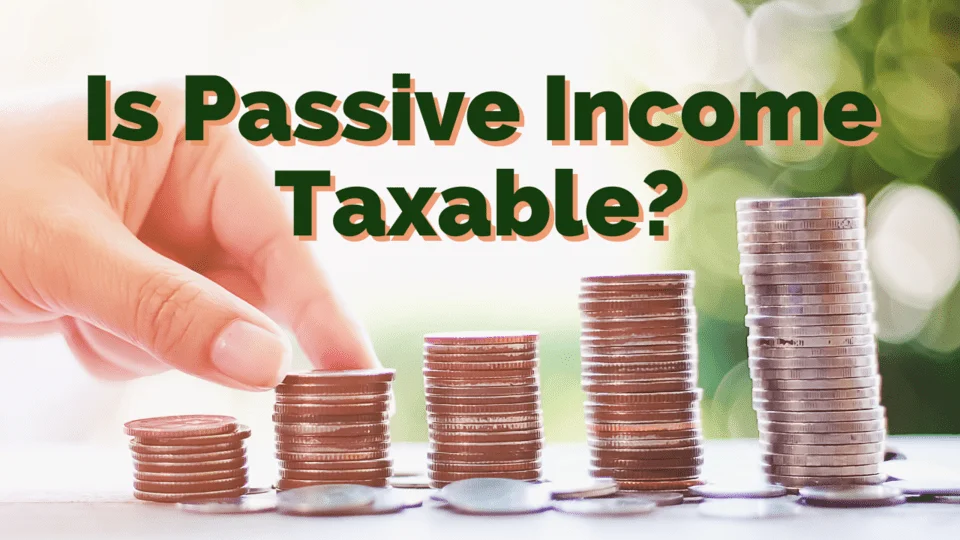Curious about what is passive income stream and why it’s a total game-changer for your finances? Let me know if you have ever dreamed of making money while you sleep! That’s the magic of passive source of income!
Imagine having a cash flow that doesn’t tie you to a desk or demand constant work. In this post, we’re diving into the world of passive income stream—exploring what it is and why having at least one source is a total game-changer!

PASSIVE INCOME STREAM
Passive income stream is like a secret tool for financial freedom. It’s about earning without constantly working, like having a garden that keeps growing veggies without you always tending to it.
We’ll uncover different types of income sources and why it’s super important to understand these now.
By understanding this, you’re unlocking a door to financial flexibility and a life where your money works for you, not the other way around.
Say goodbye to only earning when you’re on the job and hello to a world where your money is always working for you!
So lets dive in…
- What is Passive Income Stream?
- Define Different Types of Passive Income Streams?
- Is Passive Income Taxable?
- Best Forms of passive income Sources
- What is Passive Income Investments?
- What is Passive Income Apps?
- What is Passive Income Side Hustles?
- Exploring Best Passive Income Ideas
- Why You Must Have Least One Passive Income Source?
- How to make passive income?
- Conclusion
What is Passive Income Stream?
Passive income stream is like money that comes to you without needing to work all the time. But what does passive income mean, really? It’s like having a tree that keeps giving fruit without you having to plant it over and over again.

This income doesn’t need you to be constantly on the clock; it keeps flowing in even when you’re not actively working. So, what’s passive income? It’s about creating ways to earn that don’t tie you to a desk or a fixed schedule.
Let’s define passive income stream in simpler terms. It’s the cash you make from ideas that work for you, like renting out a space or earning from investments.
This income isn’t about the usual 9-to-5 grind; it’s about setting up streams of money that keep coming, giving you more freedom and flexibility.
Understanding the passive income meaning opens doors to financial independence. It means having money work for you, not just you working for money.
It’s a smart way to build a more secure financial future, allowing you to live life on your terms. That’s the beauty of this types of income—it gives you the chance to earn while you focus on living!
Misconceptions about Passive Income Stream
Many people mistakenly consider passive income as a quick and effortless solution to financial woes. However, building passive income requires dedication and the right approach.
It is not a side hustle, a salary increase in your job, or a get-rich-quick scheme. Passive income demands either an initial investment of time or money to create a sustainable income stream.
It could be either real estate or any type of business, that requires very little or no effort to run. But, remember, this is not a get-rich-quick scheme. There is great truth behind Earning Passive Income. Here, you have two choices…
- Invest Your Time & Efforts:- Time is the most important investment. You can’t make anything out of nothing. If you wish to create a passive income source, at first, you need to invest your time. in order to create something which will then become an asset. This will allow you to earn passive income.
- Invest Your Money:- If you do not want to invest your time & Efforts in creating something, you have to invest your money. You must invest your money in something out there, such as real estate, an automobile, digital products, or any other business. Your money will work for you, allowing you to earn passive income.
Consequently, it is up to you whether you want to invest your time or your money. Passive income doesn’t require any secret method to start.
Identifying What is Not a Passive Income Stream!
It’s essential to distinguish between passive income stream and other forms of earning. Passive income is not your regular job, a side hustle that requires consistent effort, or consulting where you trade time for money.
Passive income should be a source of revenue that continues to flow with little ongoing involvement.
The majority of people misunderstand passive income as a side hustle. It is possible to increase your current income with a side hustle, but you need to put in the time and effort every day.
Your passive income is not a…
- Your Job:- Passive Income means investing time and effort for a period of time, which can be a few days, months, or years. However, it will then generate regular monthly income and allow you to retire early. An increase in salary in your main job is not passive income but a Active Income Source.
- A Side Hustle:- A Side hustle is not a passive income stream. Perhaps your side hustle can generate passive income in the future, such as teaching online and recording your classes. You won’t generate passive income until you upload these classes to digital platforms. Such as Teachable or Skillshare.
- Consulting:- The consulting or giving of business advice can be a very rewarding side of the business. Here, however, you charge by the hour or by the meeting, so you are trading your time for money. Therefore, it cannot be a passive income stream, however, if you develop a course around your expertise and sell it online. Eventually, you will be able to earn passive income from it.
Define Different Types of Passive Income Streams?
Discovering ways to make money without constant work is exciting! Passive income sources come in various forms, like renting out property, earning from investments, or creating content online. But basically we can divide it into 3 main categories…

- Income From Property Investment
- Income From Money Investment
- Income From Time & Effort In
Let’s explore these 3 types of passive income streams now…
Income From Property Investment:
Generating passive income through property investment involves owning real estate properties that are rented out to tenants. This income stream can come from residential properties, commercial spaces, or vacation rentals.
The rental income earned becomes a consistent source of passive earnings, although property management might require some involvement.
Examples of Passive Income Stream:-
passive income from property investments include…
- Rental Properties: Earning passive income by renting out houses, apartments, or commercial spaces.
- Real Estate Crowdfunding: Investing in real estate projects through online platforms, receiving returns without direct property management.
- Vacation Rentals: Generating income by renting out vacation homes or properties on short-term rental platforms.
- Real Estate Investment Trusts (REITs): Passive income from investing in trusts that own and manage income-producing properties.
- Land Ownership: Earning passive income from leasing or renting out land for agricultural, commercial, or residential purposes.
Income From Money Investment:
Passive income through money investment refers to earning profits or returns from investments made in various financial instruments.
This could include dividends from stocks, interest from bonds, or capital gains from mutual funds or real estate investment trusts (REITs). The key here is investing money in different avenues and letting it grow or earn returns over time.
Passive Income Examples From Money Investment…
- Stock Dividends: Earning dividends from stocks without actively trading them.
- Bond Interest: Generating passive income through interest payments from bonds.
- Mutual Fund Profits: Passive income from mutual funds through capital gains or dividends.
- Real Estate Investment Trusts (REITs): Profits from investing in REITs, which generate rental income or capital appreciation.
- Peer-to-Peer Lending Returns: Earning interest as a lender through online lending platforms without active involvement in borrowing decisions.
- Savings Account Interest: Generating passive income from interest earned on savings or high-yield accounts.
- Profit From Businesses as a Passive Investor: Earning passive income by investing in other people’s businesses without active involvement in daily operations. This can involve owning shares or having a stake in a company where profits are distributed to investors without direct participation in management.
Income From Time & Effort In:
Passive income from time and effort invested typically involves creating digital products or content initially, which continue to generate income afterwards.
This could encompass writing an e-book, developing an online course, creating software, or building a successful blog or YouTube channel.
While the upfront effort can be substantial, the content continues to earn income without requiring continuous, active involvement once established.
Each of these passive income streams has its advantages and considerations, offering individuals various ways to generate income without solely relying on active employment.
Income Examples From Time & Effort Investment…
- Digital Products: Creating and selling e-books, online courses, or software that generate ongoing income.
- Blogging & Affiliate Marketing: Earning through blogs by promoting products/services and earning commissions as an affiliate.
- YouTube Channel: Generating passive income from ad revenue on videos created and uploaded to YouTube.
- Podcasting: Creating podcasts with sponsorships or advertisements for passive income sources.
- Membership Sites: Generating recurring income by offering exclusive content or services for a subscription fee.
- Dropshipping or E-commerce: Setting up an online store with dropshipping or e-commerce platforms to earn income without handling inventory directly.
Is Passive Income Taxable?
Yes, passive income is typically taxable. The taxation of passive income can vary based on the source of income and local tax laws.

Rental income, dividends from investments, interest earned from savings or bonds, and profits from passive businesses are usually subject to taxation.
Tax rates and rules may differ depending on the type of passive income and your country’s tax regulations. It’s advisable to consult with a tax professional or accountant to understand the specific tax implications related to your passive income sources.
How is Passive Income Taxed?
Passive income is generally taxed differently from earned income, like wages or salaries. The taxation of passive income varies based on the source of income and local tax laws. Here are some common forms of passive income and their tax treatment:
- Rental Income: Rental income is usually taxed as ordinary income and is subject to income tax. Expenses related to managing the rental property can often be deducted, reducing the taxable income.
- Investment Income: Dividends from stocks, interest from bonds, and capital gains from investments are typically taxed at different rates. Qualified dividends and long-term capital gains often have lower tax rates than ordinary income.
- Royalties: Income from royalties, such as those earned from creative works or licensing agreements, is usually considered ordinary income and is taxed accordingly.
- Passive Business Income: Profits from passive businesses where the individual is not materially involved are often subject to passive income tax rates, which may differ from active business income tax rates.
It’s important to note that tax laws can change and vary by jurisdiction, so it’s wise to consult with a tax professional or accountant to understand the specific tax implications of your passive income sources and any deductions or credits available to you.
Additionally, different types of passive income might have different tax treatments, so it’s crucial to stay informed about the tax regulations relevant to your situation.
Best Forms of passive income Sources
The best forms of passive income can vary based on individual preferences, financial goals, and available resources. Some effective forms of passive income include:
- Dividend Stocks: Investing in stable companies that pay regular dividends can provide a steady stream of passive income.
- Rental Properties: Owning and renting out real estate properties can generate consistent passive income through rental payments.
- Interest-Bearing Investments: Bonds, certificates of deposit (CDs), or high-yield savings accounts can generate passive income through interest payments.
- Digital Products: Creating and selling digital products like e-books, online courses, or software can yield passive income through sales.
- Real Estate Crowdfunding: Investing in real estate projects through online platforms can provide passive income without direct property management.
- Peer-to-Peer Lending: Acting as a lender through online platforms and earning interest on loans made to individuals or businesses.
- Dividend-Paying ETFs: Exchange-traded funds (ETFs) that focus on dividend-paying stocks can offer passive income and diversification.
- Royalties: Earning royalties from creative works, patents, or licensing agreements can provide ongoing passive income.
The “best” form of passive income often depends on factors such as risk tolerance, initial investment capabilities, time commitment, and personal interests.
Diversifying across multiple streams of passive income can also be a smart strategy to minimize risk and maximize overall returns.
What is Passive Income Investments?
Passive income investments refer to various financial endeavors or assets that generate income with minimal ongoing effort or active involvement.
These investments are designed to produce passive income streams without requiring constant management or active participation. Examples of passive income investments include:
- Dividend-Paying Stocks: Investing in stocks of companies that distribute dividends to shareholders regularly.
- Bonds: Purchasing bonds that pay periodic interest to investors.
- Real Estate Investment Trusts (REITs): Investing in trusts that own and manage income-generating real estate properties.
- High-Yield Savings Accounts or CDs: Depositing funds in savings accounts or certificates of deposit that accrue interest over time.
- Peer-to-Peer Lending Platforms: Acting as a lender through online platforms and earning interest on loans made to borrowers.
- Index Funds or ETFs: Investing in diversified funds that track specific indexes, often providing regular distributions or dividends.
These passive income investments typically require an initial capital investment and may involve varying degrees of risk.
The goal is to generate consistent income over time without the need for constant active involvement, allowing individuals to build a diversified portfolio and create financial stability.
READ MORE:- 👉 Passive Income Investments:- Investing for Effortless Earnings
What is Passive Income Apps?
Passive income apps are mobile applications designed to help users generate additional income with minimal effort. These apps offer various ways to earn money or rewards passively by performing simple tasks, participating in surveys, watching videos, or engaging in activities that do not require active involvement.
Examples of passive income apps include:
- Survey and Task Apps: Platforms that offer users the chance to earn rewards or cash by completing surveys, downloading apps, or performing small tasks.
- Cashback and Rewards Apps: Applications that provide cashback or rewards for shopping, scanning receipts, or making specific purchases through affiliated retailers.
- Investment Apps: Some investment apps offer round-up features that invest spare change from transactions or allow users to invest in portfolios passively.
- Data Collection Apps: Certain apps collect anonymized data on users’ activities or behaviour in exchange for compensation.
- Ad-Watching Apps: Apps that reward users for watching advertisements or videos.
These apps can provide additional income or rewards over time, but it’s essential to be cautious and choose reputable apps, as some may have limitations, payout thresholds, or privacy considerations.
Users should review terms, conditions, and user reviews before using these apps to ensure legitimacy and compatibility with their goals.
READ MORE 👉 Passive Income Apps:- Passive Income at Your Fingertips
What is Passive Income Side Hustles?
Passive income side hustles are extra ways to make money that don’t need constant attention. These are activities or projects you do on the side that keep earning you money even when you’re not actively working on them all the time.
For example, creating and selling digital products like e-books, renting out a spare room on Airbnb, or investing in stocks that pay dividends can be side hustles that bring in money without needing your full-time focus.
The idea is to set up these small businesses or projects that keep running and making money in the background, giving you an extra income source alongside your main job or activities.
READ MORE 👉 Best Passive Income Side Hustles Worth Exploring for Newbies
Exploring Best Passive Income Ideas
Now, it’s time to build your own passive income stream that lets you live life your way. Discover the perfect idea that fits just right for you.
I’m here to explore some amazing ideas tailor-made for…
beginners, students, teens, nurses, and even those with a little money to start.
Want to learn more about these awesome ideas? Read More on and dive deeper into the details. These ideas are all about making money without working around the clock.
Ready to explore and find the perfect fit for you? Let’s jump in and uncover your path to earning money effortlessly!
Why You Must Have Least One Passive Income Source?
Imagine having money coming in, even when you’re not actively working. That’s what a passive income source does. It’s like a safety net for your finances. Here’s why having at least one is super important:
- Extra Security: If your regular job is ever uncertain, a passive income source can help cover your expenses.
- Mixing Things Up: Relying only on a job can be risky. Having different ways to earn money is like spreading your bets to be safer.
- More Freedom: Passive income stream gives you the freedom to do other things you love without worrying about money all the time.
- Growing Your Money: It’s like planting seeds that grow into more money over time. This helps you build wealth and be more financially secure.
- Planning for the Future: When you stop working, passive income sources can continue, making your retirement more comfortable.
- Less Stress: Knowing you have money coming in from different places can make life less stressful and more enjoyable.
Having a passive income source is like having a financial superhero that watches out for you, making life smoother and more secure.
How to make passive income?
Discover the secrets to making money while you sleep! In our detailed guide, we will uncover practical ways to create passive income streams. From investing in real estate to launching an online business, there’s an option for everyone.
Ready to turn your dreams of financial freedom into reality? Dive into the full post for an in-depth look at each method and start your journey toward a more secure and flexible financial future!
READ MORE 👉 How to Make Passive Income – Your Ultimate Guide
Conclusion
Passive income is a game-changer, offering financial stability and freedom. I’ve explored diverse passive income sources with you. While passive income apps, side hustles, and investments open doors, relying solely on passive income may pose risks. Diversification is key—having at least one passive income source is vital for stability.
This guide’s comprehensive insights into passive income sources and taxation shed light on its potential and pitfalls.
Ready to embark on your journey towards financial security? Start exploring passive income avenues wisely for a more secure financial future.
I hope you liked this detailed post “What is Passive Income Stream & Why Creating One is Always Crucial?” and found it super helpful. Feel free to share it with your friends so they can learn too! I’ll be back with more cool stuff to help you set up your own passive income stream.
Thanks for reading, and have an awesome day ahead!



